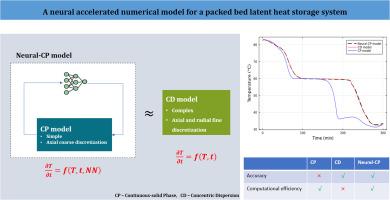填料床潜热蓄热系统的神经加速数值模型
IF 9.6
Q1 COMPUTER SCIENCE, ARTIFICIAL INTELLIGENCE
引用次数: 0
摘要
为填料床潜热储热系统(PBLHS)建立准确且计算高效的动态模型对于可靠地预测其在不同操作场景下的性能,并使其能够在规划和实时控制中使用至关重要。本文通过将神经网络(NN)与粗离散的连续固相(CP)模型方程相结合,提出了一种新的PBLHS神经加速数值模型。嵌入式神经网络以相变材料(PCM)的流体温度和焓为输入,预测相变材料(PCM)的表面温度,这是CP模型无法捕获的。这使得神经加速模型能够复制高保真度和计算昂贵的模型即同心色散(CD)模型的准确性。提出了一种创新的数据生成过程,用于同时生成CD模型和CP模型的神经网络训练数据。提出了两种版本的神经加速模型,一种是使用传统的神经网络,另一种是使用带有自定义激活函数的神经网络。与高精度的CD模型相比,这两个版本都表现出优异的精度,MSE低至0.117°C, R2值接近0.995,错误率低于0.394%。在计算效率方面,所提模型分别实现了342倍和764倍的加速。通过使用从自定义激活函数中受益的紧凑体系结构,同时还增强了模型的可解释性,为所建议模型的后续版本获得了更多的加速。这些结果突出了该模型对高精度和计算效率要求高的场景的适用性。本文章由计算机程序翻译,如有差异,请以英文原文为准。

Neural-accelerated numerical model for packed bed latent heat storage system
Developing accurate and computationally efficient dynamic models for packed-bed latent-heat storages (PBLHS) is crucial for reliably predicting their performance across different operating scenarios and enabling their use in planning and real-time control. In this study, a novel neural-accelerated numerical model for PBLHS is proposed by coupling a neural network (NN) into a coarsely discretized equations of the Continuous-solid Phase (CP) model. The embedded NN predicts the surface temperature of the phase change material (PCM) given the fluid temperature and enthalpy of the PCM as inputs, which the CP model fails to capture. This allows the neural-accelerated model to replicate the accuracy of a high-fidelity and computationally expensive model namely Concentric Dispersion (CD) model. An innovative data generation process to generate training data for NN involving both CD and CP model is proposed. Two versions of neural-accelerated model are proposed, one with conventional NN and another using NN with a custom activation function. Both versions demonstrate an excellent accuracy, achieving MSE as low as 0.117 °C, values closer to 0.995 and error percentage below 0.394 compared to the highly accurate CD model. As for computational efficiency, the proposed models achieved 342 times and 764 times acceleration respectively. The gain in more acceleration for the later version of the proposed model is achieved through the use of a compact architecture that benefits from the custom activation function, while also enhancing model explainability. These results highlight the model’s suitability for scenarios demanding both high accuracy and computational efficiency.
求助全文
通过发布文献求助,成功后即可免费获取论文全文。
去求助
来源期刊

Energy and AI
Engineering-Engineering (miscellaneous)
CiteScore
16.50
自引率
0.00%
发文量
64
审稿时长
56 days
 求助内容:
求助内容: 应助结果提醒方式:
应助结果提醒方式:


